 The New World. |

In most of Latin America, a few basic types of sausages are consumed, with slight regional variations on each recipe. These are chorizo (raw, rather than cured and dried like its Spanish namesake), longaniza (usually very similar to chorizo but longer and thinner), morcilla or relleno (blood sausage), and salchichas (often similar to hot dogs or Vienna sausages). Beef tends to be more predominant than in the pork-heavy Spanish equivalents. Argentina and Uruguay
 The Pancho hot dog from Argentina. |

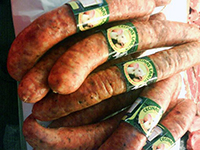 Chilean longanizas. |
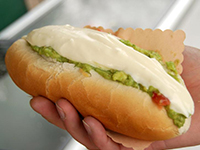 Chilean "Completo" hot dog with a generous copping of mayonnaise. |

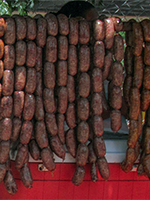 Venezuelan chorizo. |

In Mexico, the most common Mexican sausage by far is the chorizo. It is fresh and usually deep red in color (in most of the rest of Latin America, chorizo is uncolored and coarsely chopped). Some chorizo is so loose that it spills out of its casing as soon as it is cut; this crumbled chorizo is a popular filling for torta sandwiches, eggs, breakfast burritos and tacos. Salchichas, longaniza (a long, thin, lightly spiced, coarse chopped pork sausage), moronga (a type of blood pudding) and head cheese are also widely consumed. Mexican chorizo is a chile- and garlic-flavored sausage, originally derived from the Spanish sausage of the same name, but has evolved over the last few centuries to be distinctly Mexican. Mexican chorizo is made of pork, but also of young goat, javalina, venison, occasionally beef, or where meat is scarce, just about anything available. The meat is usually ground rather than chopped, and different seasonings are used.
 Mexican taco with Sonoran chorizo. |
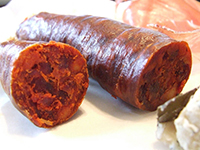 Spanish chorizo. |
|
Sonoran chorizo recipe: Ingredients
|
Both Spanish and Mexican chorizo would fall in the category of Rohwursts, in that they are not thermally treated in any way before insertion into the casing. However, the two are two different beasties altogether. The Spanish variety is a fermented, smoked sausage, while the Mexican variety is a raw wurst similar in terms of the manufacturing process (not taste) to the German bratwurst.
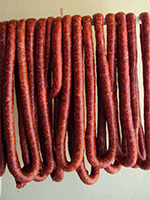 Mexican chorizo from Toluca. |

 |
According to The National Hot Dog & Sausage Council, in 2013 Americans spent nearly $3 billion on wurst alone, roughly the entire gross domestic product of Eritrea.
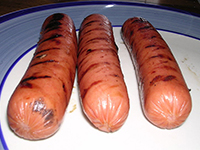 Würstchen known as the American Hot Dog. |
 Feltman's restaurant on Coney Island. |
 The classic American hotdog in a bun with mustard. |
Other people have claimed the fame of introducing the hot dog to America. There was Antonoine Feuchtwanger, who sold hot dogs on the streets of St. Louis in 1880. There was Anton Ludwig Feuchtwanger, who served sausages in rolls at the 1893 World's Columbian Exposition in Chicago and at the 1904 Louisiana Purchase Exposition in St Louis.
Popular theory has it that the substitutuion of the name "dog" for the fine nuances of Frankfurter Würstchen, Frankfurter Rindswurst and Wiener Würstchen reflected the widespread accusations that dog meat had ben used in sausages in America since the mid 1800s.
 Hot dog stands in New York City, circa 1906. |
 A typical American hot dog. |

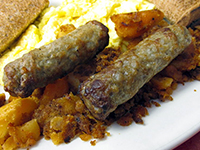 Breakfast sausage served at Ye_Olde_Cottage_Restaurant in Weston, Massachusetts. |

Bratwurst made it to the United States and is very common in area with high original German population, such as Wisconsin. It was quickly shortened to "brat" and is a common sight at summer cookouts alongside the hot dog. The bratwurst was popularized in Sheboygan County, Wisconsin in the 1920s. In general, each local butcher shop would take orders and hand make bratwurst fresh to be picked up on a particular day. The fat content of the sausages was substantial, making daily pick up necessary to avoid spoilage. The bratwurst also became popular as a mainstay of sports stadiums after Bill Sperling introduced bratwurst to Major League Baseball in Milwaukee County Stadium in 1954. The brats, which sold for 35 cents then, were grilled and placed into a container of a special tomato sauce before being served. The bratwurst were such a hit that Duke Snider of the Brooklyn Dodgers took a case back to New York. Currently Miller Park in Milwaukee, Wisconsin is the only baseball stadium that sells more bratwurst than hot dogs.
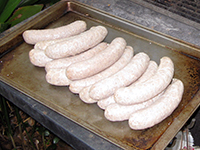 Raw American brawurst from a small craft farm in Texas. |
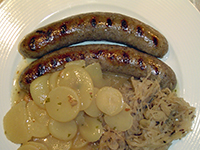 Grilled American brawurst, served with a traditional German potato salad and sauerkraut. |

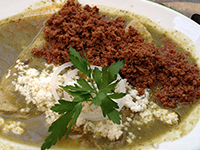 Enchilada with chorizo. |
Spain owned everything from present-day Mexico up to and including present-day Texas, New Mexico, Arizona and California, plus Florida, in the form of the Viceroyalty of New Spain (Virreinato de Nueva España). At its greatest extent, it included all of present-day Mexico and Central America except Panama, and most of the present-day United States west of the Mississippi River, plus Florida. New Spain also ruled significant real estate in the Pacific as well as in the Caribbean. The capital of New Spain was Mexico City. It was ruled by a viceroy, governing the various territories on behalf of the King of Spain.
Britain, at the time, was a minor player having a narrow strip of 13 relatively small colonies nested along the Atlantic coast.
This all changed in the middle of the 18th century at the end of the Seven Years' War, which Britain won and france lost. It was the end of Nouvelle France, with significant parts of formerly french-ruled territory now becoming British and Spanish. While New France folded in 1763, New Spain lasted until 1821. Independence from Spain was declared on September 15, 1821 and a Mexican monarchy was established.
Without going into too much detail, France had significant political and cultural control over north America until mid-18th century. Spain had the same until the first half of the 19th century. These empires obviously served as a vehicle to spread traditions, including cuisine. It is therefore no wonder that the traditional cuisines in Texas, New Mexico, Arizona and California are heavily influenced by Mexican cooking. However, they are not the same as Mexican cuisine in Mexico. For example Tex-Mex (the traditional food in Texas) is country-style food eaten by vaqueros or cowboys, having little to do with what the Spanish and later Mexican upper crust ate in Mexico City or Veracruz.
The chorizo sausage is a good example fo this. Although delicious, it is basically a low-grade bratwurst, made with ground pork and spices stuffed into a pork-intestine casing, or sold as is to serve as a filling for tacos or enchiladas. It came from Mexico, because firmly established in the northern reaches of the Mexican empire, and when these Mexican territories became states of the United States, the sausage spread on from there. That is how the chorizo found its way throughout the present-day United States.
Mexican chorizo is a chile- and garlic-flavored sausage, originally derived from the Spanish sausage of the same name, but has evolved over the last few centuries to be distinctly Mexican. It is a fresh sausage (Rohwurst), therefore has to be cooked thoroughly. Most chorizo in the United States is made from pork. Mexican style chorizo is fresh, quick cooking and the stuff of queso fundido, huevos con chorizo, tacos and many other comfort food goodies.
Other dishes include:
Poblano chorizo potato salad
Chorizo, Potato, And Egg Breakfast Tacos
Beef And Chorizo Burritos
Huevos con chorizo served on tortillas with cheese
Mixed with black beans or refried beans, served on tortillas or as a dip
Mixed with cheese for queso fundido
On pizza crust with tomato sauce and a blend of grated Monterey Jack and Cheddar
On tortilla chips topped with grated cheese for nachos nachos

"Italian Sausage" in the United States is a coarse-grained pork sausage seasoned with fennel and/or anise. The two most common varieties marketed in US grocery stores hot and sweet (mild). The main difference is the addition of hot red pepper flakes in the former.
Italian Sausage is a Rohwurst in that it has not been thermally treated in any way before insertion into casing and delivery. In terms of its manufacture (not taste), it is similar to the German bratwurst or Mexican chorizo.
This is a widespread wurst that is ubiquitous throughout the United States. However,
one would not find "Italian Sausage" in a butcher shop in Italy or elsewhere in Europe.
Asking for "Italian Sausage" would be like asking for "Swiss Cheese":
"Which kind would you like, monsieur? Would you fancy Emmentaler or Gruyère or Bergkäse,
Appenzeller or Tilsiter?"
.... or any of the other 450 types of cheese that exist
in Switzerland? Asking for "Italian Sausage" in in Europe would generate equally blank stares.
That is because what is understood in the United States as "Italian Sausage" is a regional
variety most likely from sicily, which was brought along with Italian immigrants who mainly
came from southern Italy. The main period of Italian immigration to the United States took
place in the period of 1880-1914, following the Italian unification in 1861.
Following a tumultuous history throughout the 19th century, which is far beyond the scope of this essay, Italy became a unified constitutional monarchy on 18 February 1861, with Victor Emmanuel II as the ruler based in Rome, the new capital, and a parliament based in Turin. On 17 March 1861, the parliament proclaimed Victor Emmanuel II the King of Italy, and on 27 March 1861 Rome was declared Capital of Italy. The unification caused a deterioration of the economic conditions in many parts of southern Italy and Sicily, including the new government’s allocation of much more of its resources to the industrialization of the North than to the South, an inequitable tax burden on the South, tariffs imposed on the products from the South, soil depletion and deforestation, not to forget a military conscription lasting seven years. The economic situation became untenable for many sharecroppers, tenant farmers, and small business and land owners. Multitudes chose to emigrate rather than face the prospect of a deepening poverty. Many of these were attracted to the U.S. which, at the time, was actively recruiting workers from Italy and elsewhere to fill the labor shortage that existed in the years following the Civil War. Often, the father and older sons would go first, leaving the mother and the rest of the family behind, until the male members could afford their passage. From 1880 to 1920, an estimated 4 million Italians arrived in the United States, the majority from 1900 to 1914. Between 1876 and 1930, out of the 5 million Italians who came to the United States, 80% were from the South, from Calabria, Campania, Abruzzi, Molise, and Sicily. 2/3 of the immigrant population were farm laborers or laborers. About 50% of those who came between 1901 and 1920 repatriated back to Italy after they had earned money in the United States. Although they did not intend to stay in the United States permanently and did not integrate, in all the wave of Italian immigration lasting several decades has changed the face of the American society (as well as its cuisine).
What does this mean for "Italian Sausage"? Salsiccia (sausages) in Italy are very commonly seasoned with a combination of the following: pepper, chile, coriander, fennel, nutmeg, sugar (dextrose, sucrose). There are numerous recipes for sausage with fennel seeds (Salsiccia con semi di finocchio) in the regions of Calabria, Campania, Puglia (salsiccia con finocchietto selvatico, salsiccia piccante con finocchietto e peperoncino piccante, salsiccia dolce con finocchietto e peperoncino rosso di Senise in polvere. salsiccia piccante con finocchietto e peperoncino piccante). Some of these look remarkably similar to the "Italian Sausage" found in the United States. It is our theory that the American sausage is a direct descendant of one, or more, of these, brought to the United states in the last quarter of the 19th century, and integrated into the American cuisine.
|
"Italian Sausage" from the United States: Ingredients
|

Pepperoni sausage is an American variety of salami (Rohwurst), made from cured pork and beef. Pepperoni is characteristically soft touch, slightly smoky taste, and bright red color. Thinly sliced pepperoni is a popular pizza topping in American-style pizzerias and is used as filling in the West Virginia pepperoni roll. It is also used to make some varieties of submarine sandwiches.
The term pepperoni is a misspelling of the Italian word "peperoni", which means the plural of plural bell pepper, referring to bell peppers as such but also peperoncino and peperone piccante. The first reference using pepperoni in the United States to refer to a sausage dates to 1919. Pepperoni is a cured Rohwurst, similar to the spicy salamis of southern Italy, such as Salsiccia Napoletana piccante or the Soppressata from Calabria. The main differences are that Pepperoni has a finer grain (akin to salami of Milan, a spicyless regional variant of salami), is usually softer, and is produced with the use of an artificial casing (Italian salami are produced using natural-intestine casing). P American Pepperoni is made from pork or beef, with turkey also commonly used as a substitute. Pepperoni sausages are commonly sold in two sizes: an inch in diameter for pizza, and 2-3 inches in diameter for sandwiches. Pepperoni is sold whole, chopped, or in slices.

Other popular varieties of Italian salami include the "Genoa Salami", a fermented Rohwurst normally made from pork, but may also contain beef or be all beef. It is seasoned with garlic, salt, black and white peppercorns, fennel seeds, and red or white wine. It is believed to have originated in the city of Genoa in northern Italy, however, like in the case of "Italian Sausage", there is no actual "Salame Genovese" (Genoese Salami) back in Italy. There is a salami from Genoa called Salame (di) Sant'Olcese, which originates in the hilly interior of Genoa's hinterland. The pigs are traditionally fed acorns, chestnuts, and hazelnuts of the local Mediterranean woodlands.
American Bologna, sometimes phonetically spelled as baloney, is a descendant of the Italian Mortadella, a large pork Glühwurst Bologna. However, unlike mortadella, American Bologna can be made from chicken, turkey, beef, pork, venison or even soy protein.
"German Bologna" differs from regular American Bologna in its seasonings, most typically garlic being added to the recipe. Something like this would usually be called Lyoner or Fleischwurst in Germany and Extrawurst in Austria.
The "Lebanon Bologna" has nothing to do with the Middle East, but with Lebanon County, Pennsylvania. It was developed by the Pennsylvania Dutch, who themselves are not Dutch but mostly German, having come from southwest Germany (Baden-Württemberg and Rheinland Pfalz), Alsace, Switzerland and even France. When they came, they spoke a dialect of German (Deutsch), which became Americanized as "Dutch".
Lebanon Bologna sausage is a type of cured, smoked, and fermented semi-dry sausage made of beef. It is similar in appearance and texture to salami, though somewhat darker in color. Lebanon bologna has a distinct tangy flavor, moreso than other fermented meat products such as summer sausage. Hardwood smoking imparts a strong smoky flavor to the traditionally prepared versions of the product. It was developed in the 19th century.
Lebanon Bologna is available in markets throughout the United States and typically served as a cold cut, as well as an appetizer. Four versions exist, including original, sweet, double-smoked and honey-smoked.

Switching gears to French-American cuisine, in Louisiana, there is a variety of sausage that is unique to its heritage, a variant of the French Andouille. Unlike the original variety native to Northern France, Louisiana andouille has evolved to be made mainly of pork butt, not tripe, and tends to be spicy with a flavor far too strong for the mustard sauce that traditionally accompanies French andouille: prior to casing, the meat is heavily spiced with cayenne and black pepper. The variety from Louisiana is known as Tasso ham and is often a staple of both Cajun and Creole cooking. Traditionally it is smoked over pecan wood or sugar cane as a final step before being ready to eat. In Cajun cuisine, boudin is also popular.
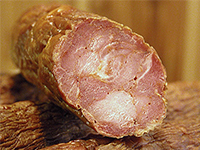 Cajun Andouille sausage. |
Cajun andouille sausage is an essential ingredient of the Louisiana gumbo soup.

The American Liverwurst is an anglicization of German word "Leberwurst" (liver sausage"). In the Midwestern United States, Liverwurst is also known as Liver Sausage or Braunschweiger. American Liverwurst usually contains pigs' or calves' livers. Other ingredients are meat (notably veal), fat, and spices including ground black pepper, marjoram, allspice, thyme, ground mustard seed, or nutmeg.
In the United States, Liverwurst is eaten spread on traditional or as open-faced sandwiches. It is popular in North America with red onion and mustard on rye or whole grain bread. Liverwurst is typically served on crackers or in sandwiches. Most of the time it's sold as slices rather than spreads.
Head Cheese in North America, Brawn in England and Australia, and Potted Heid is used in Scotland, is a Kochwurst generally equivalent to Presswurst in Austria and Germany, or the Czech Huspenina, Sulc or Tlačenka. In Louisiana, there is a variety of head cheese made, which is nicely seasoned with cayenne pepper (after all, what in Louisiana is not seasoned with cayenne pepper?).



Sources:
- Alexandra Molnar December 19, 2010, From Europe to America: Immigration Through Family Tales, http://www.mtholyoke.edu/~molna22a/classweb/politics/index.html
- Fleischtheke.info
- Wurst.de
- Wikipedia
back to Radim and Lisa's Well-Travelled Cookbook | email us
Last updated: May 10, 2014
Certain images from Wikimedia Commons, used under the terms of the GNU Free Documentation License.